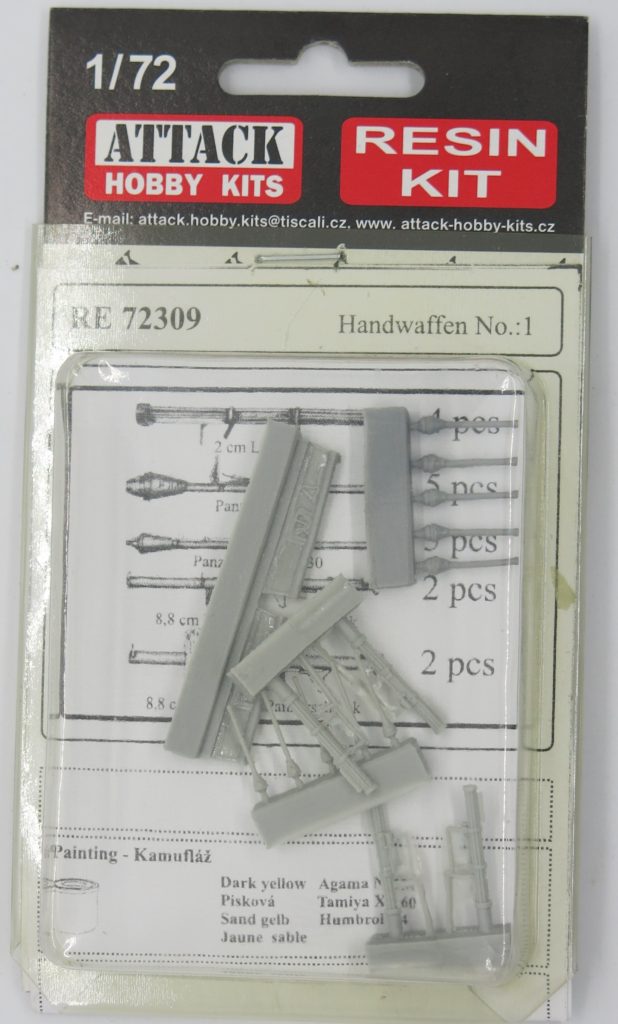After a long time, we are returning a set of cast German hand
anti-tank weapons in scale 1/72 scale from the Second World War to the market. Fits as addition to models of technology or to dioramas in scale 1/72. The package contains Luftfaust, Panzerfaust, Panzerfaustklein and Panzerschreck.
Link to e-shop: https://attack-kits.eu/en/handwaffen-no-1.html


Panzerfaust
The most famous of these weapons is undoubtedly the Panzerfaust. The set contains
two versions of this weapon – a smaller Panzerfaust 30 and a larger Panzerfaust 60. The number indicates the range of the weapon (e.g. the weapon reached 30 m or
60 m). The set includes five pieces of both versions of Panzerfaust handguns.
The disadvantage of Panzerfaust was a small range. This fact caused that shooters were threatened
by enemy missiles and in case of success also by flying fragments of the victim
car. Another disadvantage was their single use. Panzerfaust had a lot of advantages also:
compact dimensions, high efficiency and cheap production.
This weapon was used by both the Wehrmacht and its allies from Finland, Italy and Hungary.
The captured weapons, on the other hand, were used during the uprisings in Warsaw, Prague and they were also used by the Red Army at the end of the war.

Panzerschreck
During the fighting in Africa, the German army captured several pieces of American “Bazuk”.
According to “Bazuk” they developed their own weapon – Panzerschreck. The diameter of the bullet was larger (88 mm) and had greater penetration. Unfortunately, the first implementation of RPzB.43 had many shortcomings. The projectile revealed the shooter’s position with smoke after the shot. He also used protective gear like a raincoat and mask to keep him from escaping the bullet
were not injured and the range was only 30 m.
This was followed by a greatly improved design – RPzB.54. This differed at first glance with a shield protecting the shooter and thus the simplified use of the weapon. In addition, the range of the weapon increased significantly to 180 m. In this form, it was an effective weapon, although its weight increased to 11 kg without ammunition. Therefore, it required special deployment tactics and service with sufficient training. The team consisted of four soldiers with two small arms Panzerschreck. The soldiers operated in pairs: one shot and the other charged. A slightly different tactic was used at night. Against the background of the attacking tanks were flares fired and the gunners then aimed at the dark silhouettes of the tanks. This innovated weapon appeared at the end of 1944 and by the end of the war only 25 were produced together with 289 ths. pieces of bullets. (The set includes two Panzerschreck handguns in both versions.)

Lufthaus
The least known and also the least widespread weapon was the Luftfaust or Fliegerfaust.
This weapon was used by missiles with higher speeds but only with a diameter of 2 cm. On the other hand, a range of 500 m was expected, but it was never achieved.
In order to increasion of the probability of intervention, the weapon had 4, respectively 9 warheads
side by side and they fired projectiles almost at once with a special sequence – at first 4 together and then 5 in a row so as not to damage each other. The weapon was used only with a limited extent. Only 80 weapons and ammunition were produced. At the very end of the war, they were deployed both in Berlin and in defensive battles on the Western Front by the Saar River. (You will find 4 pieces of this weapon in the set.)

The weapon models are suitable not only for dioramas, but also as a supplement to German trucks.

Link to e-shop: https://attack-kits.eu/en/handwaffen-no-1.html
Suitable accessory for this car, for example: https://blog.attack-kits.eu/72923-l1500a-personnel-carrier-west-south-europe-2/
